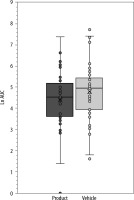Currently on Polish market there are several medicinal products designed for therapy of contact dermatitis accompanied by urticaria. Contact dermatitis may be caused by exposure to exogenous substances that elicit an immune response, resulting in inflammation in the skin and mucous membranes. Most of them contain antihistamines; therefore, their action is delayed. From a clinician’s perspective this therapeutic approach may not be sufficient to fully address the needs of patients.
In recent years an interesting therapeutic option has been reintroduced to the Polish market. A topical gel containing diphenhydramine hydrochloride 20 mg/g and lidocaine hydrochloride 10 mg/g is marketed for the symptomatic treatment of contact allergic and inflammatory skin lesions accompanied by itching, responding to treatment with antihistamines and resulting from external factors.
Scientific justification for such a combination is solid. Diphenhydramine hydrochloride (DH) selectively binds to histamine 1 receptors, thereby blocking the actions of endogenous histamine [1]. Therefore, DH could be effec-tive in treating histamine-mediated skin conditions. Lidocaine (LH) is a locally acting anaesthetic that binds to sodium channels located in the membrane of nerve cells, inhibiting the depolarisation process and the generation of an action potential. LH application may provide relief in less than 2 min [2–4]. The activity of the combination of these active substances in the symptomatic treatment of local pain and pruritus could be based on their different mechanisms of action. Lidocaine blocks pain and itching, while diphenhydramine has an antihistamine effect and thus reduces the formation of a histamine- dependent inflammatory reaction. In summary, an additive effect of these 2 active substances should be expected.
To the author’s best knowledge, most data available in public domain address the efficacy of separate components of this medicinal product but not its combination. There is one study with results provided by Marketing Authorisation Holder (MAH); these results are discussed below.
A randomised, double-blind, cross-over trial employed a pharmacodynamic model of diphenhydramine hydrochloride 20 mg/g and lidocaine hydrochloride 10 mg/g gel topical use versus placebo (product vehicle) in the treatment of local skin inflammatory and allergic lesions induced by a provocative test with histamine (skin prick test). Study included 44 healthy subjects. The primary endpoint of the study was the difference in area under the curve (AUC) calculated from the intensity of itch for the test product and placebo product assessed using a visual analogue scale (VAS) at each estimation time point. The secondary endpoints included evaluation of change in diameter of the wheal and the erythema, rate of decrease in itching, peak itch intensity, and recording of all AEs. The study was conducted in line with the Declaration of Helsinki, GCP, and relevant regulatory guidelines.
The results of the study have shown that:
Itching AUC was significantly greater for the product vehicle than for the test product (logarithmically transformed itching test vs. placebo: 4.4 ±1.4 vs. 4.8 ±1.4, p = 0.024). Comparison of logarithmically (Ln) transformed itching intensity is presented in Figure 1.
Wheal diameter was higher for the product vehicle on aver-age by 0.31 mm (p < 0.05), and the visible effect was observed after 15 min.
Itching intensity was higher for the product vehicle, on average by 2.05 points (10-point VAS was used), and it decreased with time.
A decrease in itching intensity was observed from the second minute after application of the test product (14.9 ±15.5 vs. 18.4 ±17.4; p < 0.05).
There was no significant difference in time of peak itching intensity between products and vehicle (22.8 ±16.6 vs. 24.9 ±17; p = 0.311).
No adverse effects were observed.
FIGURE 1
Box plot illustrating median ln AUC, boundaries of the box signify the lower and upper quartiles, mean values are marked with x (Student’s t-test p-value for paired data: 0.024), based on data provided by MAH

The presented results provide a clinical rationale for lidocaine and diphenhydramine combination, in symptomatic treatment of contact inflammatory, allergic skin reactions. In the author’s opinion, a combination of antihistamine and lidocaine is an interesting therapeutic option, especially in patients for whom time of action may be crucial.







